Recovering a Historical Accessory
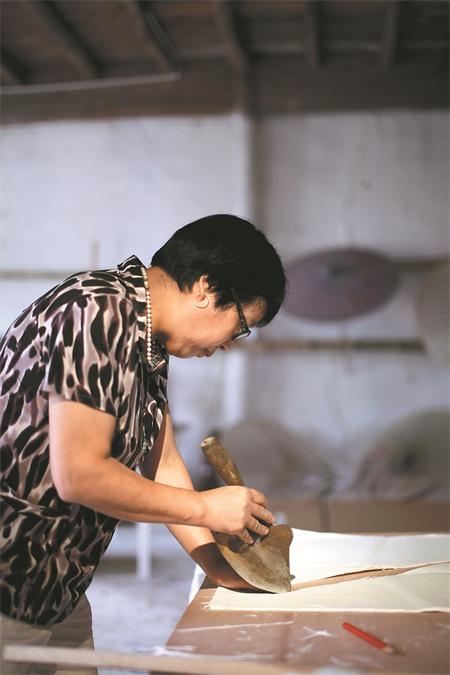 Sangpi paper is cut into small patches to make the canopy.[Photo provided to China Daily]
Sangpi paper is cut into small patches to make the canopy.[Photo provided to China Daily]
Since Liu Weixue first saw a handmade paper umbrella 17 years ago, he has been fascinated by the centuries-old craft and its techniques. At that time, little did he realize that he would, one day, bring his own contemporary touch to the once endangered tradition.
Made from bamboo and oiled paper, such umbrellas declined in appeal and production in the 1970s with the adoption of modern umbrellas. In 2007, Yuhang paper umbrella making was listed as a Zhejiang provincial intangible cultural heritage for its high artistry and sophistication.
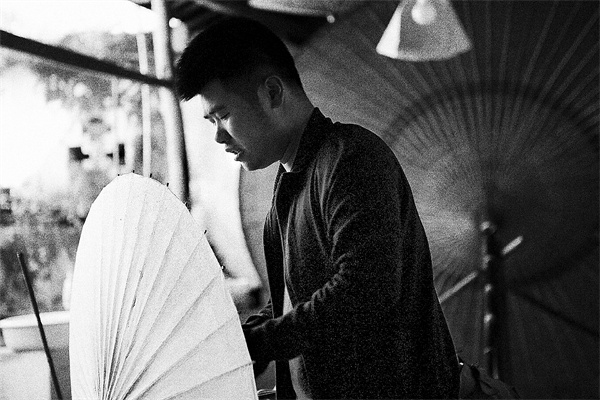 Craftspeople attach the canopy to the ribs of the umbrella.[Photo provided to China Daily]
Craftspeople attach the canopy to the ribs of the umbrella.[Photo provided to China Daily]
"Behind the umbrella is ancient wisdom, passed down through generations. I want to explore its infinite possibilities and breathe new life into umbrella making," says the 33-year-old craftsman from Yuhang district, Hangzhou, East China's Zhejiang province.
In 2015, Liu displayed a paper umbrella with a diameter spanning 3 meters at the Paris trade show Maison et Objet. In 2016, he demonstrated his work at the Milan Design Week. Last year, his umbrellas were on display at an exhibition in the Palace Museum in Beijing.
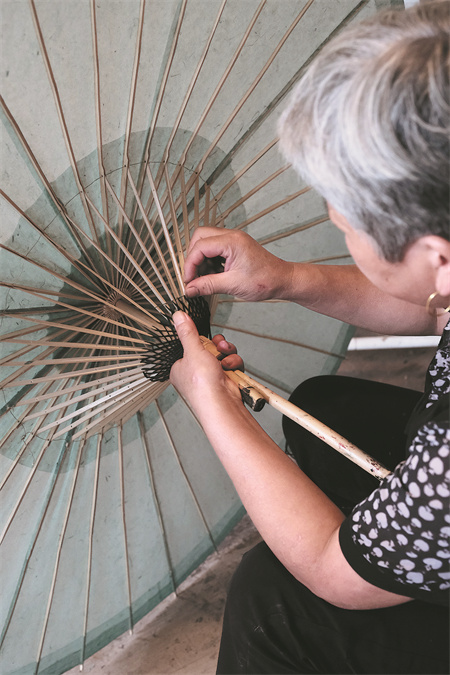 Thread is intertwined through the stretchers.[Photo provided to China Daily]
Thread is intertwined through the stretchers.[Photo provided to China Daily]
"I hope the beauty of the paper umbrella will be appreciated by more people, and it is an umbrella that can withstand a storm," Liu says.
From selecting the bamboo, cutting it into sticks, coating paper with seed oil to folding the paper canopy, it takes more than 15 days and 72 steps for three or four craftspeople to make a traditional paper umbrella, according to Liu.
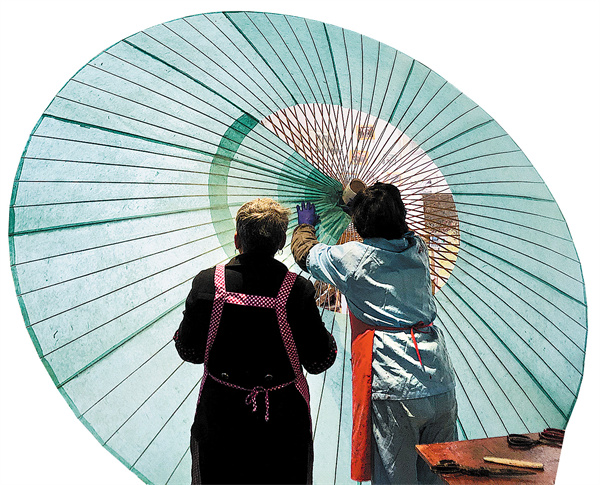 [Photo provided to China Daily]
[Photo provided to China Daily]
Every year, about 1,500 paper umbrellas are made by hand at Liu's studio, his grandfather's former residence, which sits in a bamboo forest in Xiwu village, in Hangzhou. The craftspeople follow the same processes as their predecessors did centuries before.
They cut the tortoise-shell bamboo, at about 6 years old, in winter, when the plant goes dormant and stops growing. With water evaporating from the stem, it becomes denser and can then be cut into umbrella ribs and stretchers for a year's storage, according to Liu.
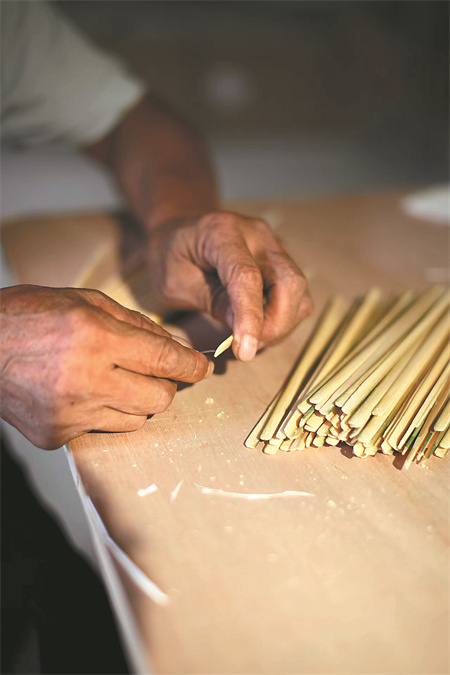 It takes more than 15 days and 72 steps for three or four craftspeople to make a paper umbrella.[Photo provided to China Daily]
It takes more than 15 days and 72 steps for three or four craftspeople to make a paper umbrella.[Photo provided to China Daily]
The canopy is made with sangpi paper, a traditional material from the inner bark of the mulberry tree. This process has a history dating back to the Han Dynasty (206 BC-AD 220). After experimenting with dozens of paper types, Liu finally found the texture and thickness of sangpi paper, made by a craftsman in Anhui province, met all his requirements.
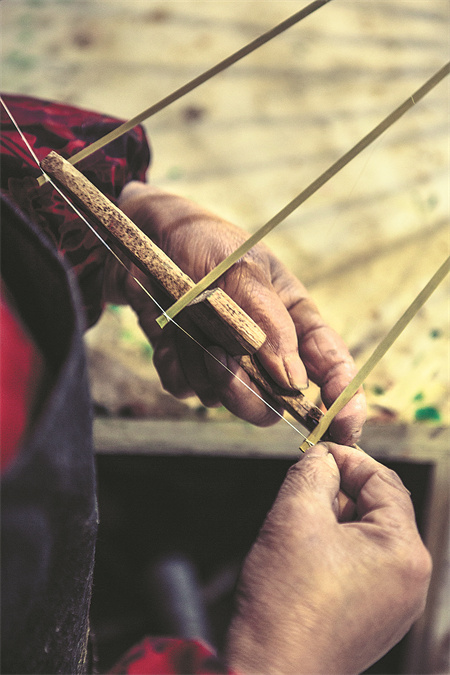 Liu Weixue learns the craft from scratch, such as sawing a bamboo culm, polishing ribs and intertwining thread.[Photo provided to China Daily]
Liu Weixue learns the craft from scratch, such as sawing a bamboo culm, polishing ribs and intertwining thread.[Photo provided to China Daily]
To prove his paper umbrella can stand the test of time, Liu sent his umbrellas to undergo quality testing and the results showed that the umbrellas can be opened and closed more than 1,000 times.
What's more, Liu wants his umbrellas to resonate with today's consumers. Applying the colors that he mixes by himself, every umbrella is dyed by hand. His shop on e-commerce platform Taobao has nearly 85,000 followers with umbrella prices ranging from hundreds to thousands of yuan.
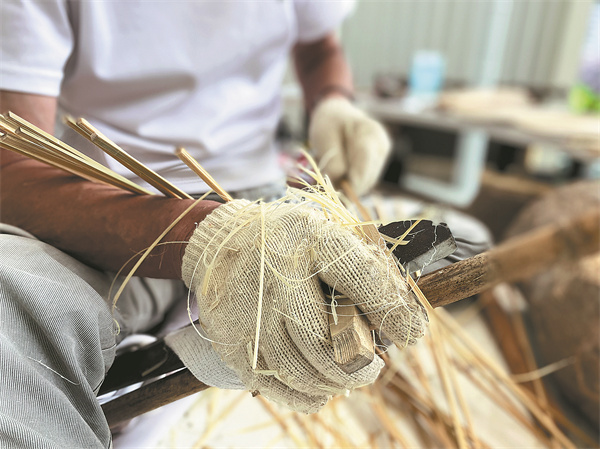 Liu Weixue learns the craft from scratch, such as sawing a bamboo culm, polishing ribs and intertwining thread.[Photo provided to China Daily]
Liu Weixue learns the craft from scratch, such as sawing a bamboo culm, polishing ribs and intertwining thread.[Photo provided to China Daily]
Reviving lost skills
The modern umbrella's origins are believed to go back a long way.
According to Yuhang County Annals, a paper umbrella store was opened in Yuhang in 1769. Consequently, Yuhang paper umbrellas were hugely popular.
In 1951, three years after the founding of People's Republic of China, the Zhejiang provincial government established a cooperative to manufacture Yuhang paper umbrellas. At its peak, nearly 5 million umbrellas were sold annually.
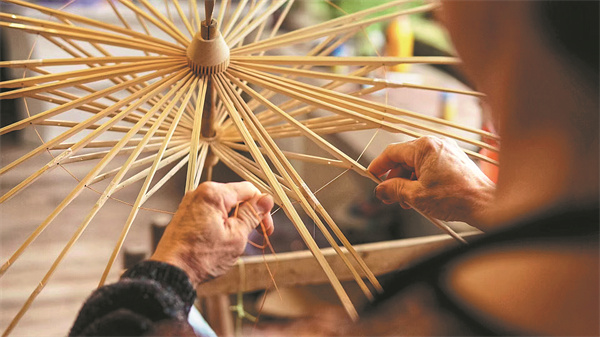 It takes more than 15 days and 72 steps for three or four craftspeople to make a paper umbrella.[Photo provided to China Daily]
It takes more than 15 days and 72 steps for three or four craftspeople to make a paper umbrella.[Photo provided to China Daily]
For 81-year-old Liu Youquan, Liu Weixue's grandfather, his childhood memories were closely connected with paper umbrellas.
But, in the 1970s, seemingly overnight, paper umbrellas disappeared as modern umbrellas became widely available.
In 1982, Liu Youquan came up with the idea of reviving the dying handicraft and bought 100 sets of bamboo frames and shafts at a price of more than 100 yuan ($14.56). It was a lot of money at that time, when a factory worker earned just dozens of yuan a month.
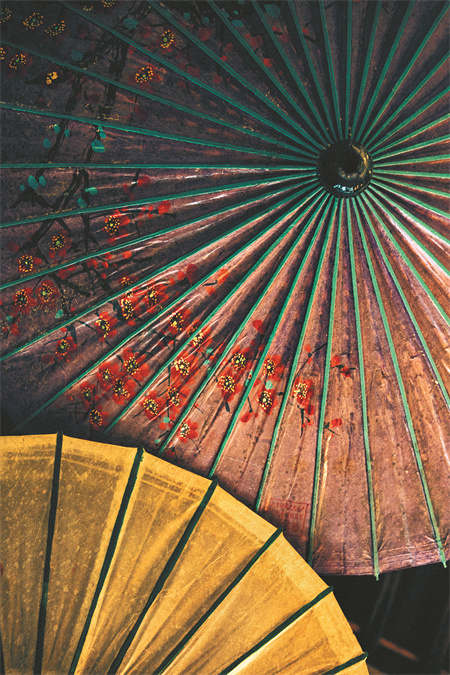 [Photo provided to China Daily]
[Photo provided to China Daily]
But Liu Youquan's plan played out as he had hoped. He was appointed manager of a paint factory that year, so he stored the umbrella parts at home where they sat for 24 years. Now retired, in 2006 Liu Youquan rekindled his passion for umbrella-making. He found four senior umbrella makers to help him revive the craft and he took on apprentices to carry on the tradition. Their average age is over 50.
In 2007, their efforts paid off when the provincial government listed the umbrella making technique as an intangible cultural heritage. However, Liu Youquan still worried about the future of the craft as there were only a handful of aging specialists left.
Liu Youquan didn't know that his revival of the craft had planted a seed in his grandson's heart. Graduating from Hangzhou Normal University in 2014 with a bachelor's degree in environmental design, Liu Weixue quit his job at a design company in Hangzhou and set up his own paper umbrella design studio in 2015.
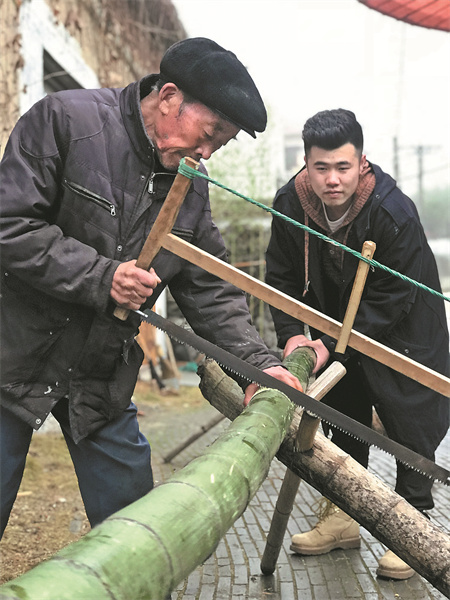 Liu Weixue (right) learns the craft from scratch, such as sawing a bamboo culm, polishing ribs and intertwining thread.[Photo provided to China Daily]
Liu Weixue (right) learns the craft from scratch, such as sawing a bamboo culm, polishing ribs and intertwining thread.[Photo provided to China Daily]
"For me, inheriting the paper umbrella making process is important, and I am very happy that my grandson is willing to take it on," Liu Youquan says.
Knowing how difficult it was to revive the craft, Liu Youquan gave his grandson a sum of 60,000 yuan to support him. At the former two-story residence of his grandfather, Liu Weixue started to learn umbrella making from scratch. In the first year, Liu Weixue had just one goal — make the umbrella and bring it to that year's Maison et Objet.
"Behind a handmade umbrella, there is a complicated process, which needs patience and care," Liu Weixue says, adding that every detail matters.
The bamboo needs to be soaked in water for 30 days and dried to prevent mold and damage by worms. Usually, an umbrella needs 36 ribs and 36 stretchers, which should come from the same bamboo culm or stem, according to Liu Weixue.
After assembling all of the components, thread is intertwined through the ribs and stretchers, carefully measured for the umbrella to open properly. Then comes attaching the canopy, which is made of small patches of glued sangpi paper. After folding the paper canopy by hand, artisans paint the canopy with a Chinese brush. The last step is to brush wax oil to the canopy twice to waterproof it.
Fang Jinquan, an umbrella maker at the studio who started learning the craft at the age of 12, says it takes at least three years to become qualified.
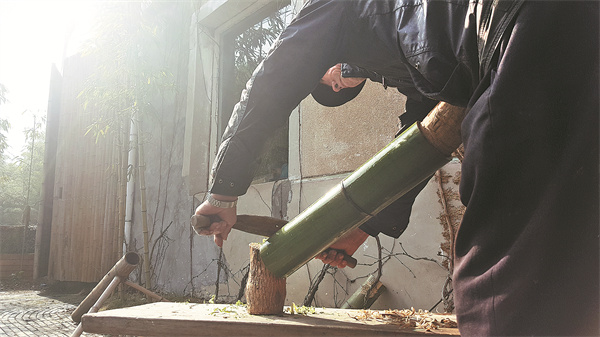 It takes more than 15 days and 72 steps for three or four craftspeople to make a paper umbrella.[Photo provided to China Daily]
It takes more than 15 days and 72 steps for three or four craftspeople to make a paper umbrella.[Photo provided to China Daily]
A modern touch
While sticking to the age-old techniques, Liu Weixue has made creative changes to find a balance between the craft and contemporary life.
As a designer himself, Liu Weixue developed the color palette for his umbrellas. In 2016, he launched a series called "Chun", and decorated them in plain colors. There are 10 colors, including gray blue, grass green, vermilion, earth yellow, cloud white and black.
As young people look to express their individuality through accessories, Liu Weixue invites artists to design patterns which are not only derived from traditional culture, but also cartoon characters. He has also collaborated with fashion brands to tap into the guochao trend, which features fashionable designs mixed with elements from traditional culture.
Inspired by the ancient Chinese myths featured in Shanhaijing, or "The Classic of Mountains and Seas", in 2018, Liu Weixue's studio and illustrator Zhang Fan created three umbrellas featuring mythical beasts that appear in the book.
In 2020, the studio and artist Guo Jiaxin added elements from the Archaeological Ruins of Liangzhu City in what is now Hangzhou into seven paper umbrellas.
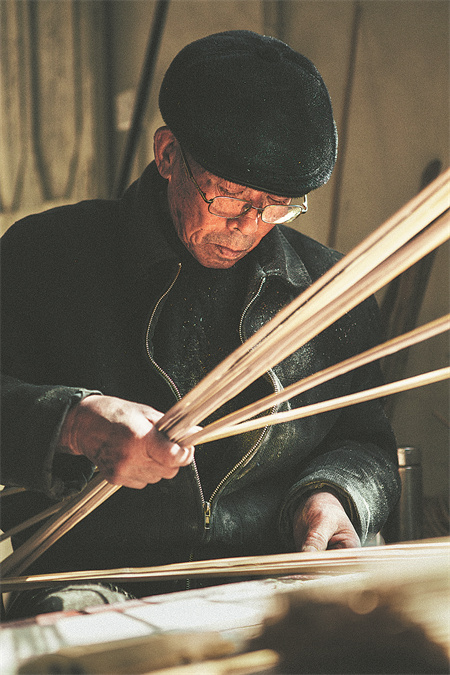 Liu Youquan checks bamboo umbrella ribs.[Photo provided to China Daily]
Liu Youquan checks bamboo umbrella ribs.[Photo provided to China Daily]
"At my studio, every umbrella is unique, because the colors are slightly different each time I mix them and every line is painted by hand," Liu Weixue says.
However, attracting young clients is not enough, he wants more than just to sell paper umbrellas.
To help more people get to know the craft, he has given lectures on the paper umbrella making at nearby schools and communities and taken his umbrellas to arts and crafts festivals and exhibitions.
In early 2020, with the support from the local government, a museum on Yuhang paper umbrellas was opened at Pingyao town in Yuhang, where visitors can see specialists at work and experience a canopy painting course.
"I hope our museum can trigger the imagination of visitors. When you take an umbrella home, as well as being functional, it can also be a decoration. For instance, put it on a stand with a bulb and it can be a pretty lamp. Exploring its possibilities in daily life keeps the ancient craft alive," Liu Weixue says.
If you have any problems with this article, please contact us at app@chinadaily.com.cn and we'll immediately get back to you.

